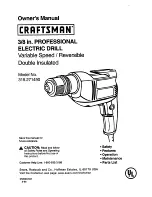
5
ENGLISH
(Original instructions)
ENGLISH
(Original instructions)
the power tool for operations different from those intended could
result in a hazardous situation.
5. Battery tool use and care
a. Recharge only with the charger specified by the
manufacturer.
A charger that is suitable for one type of battery
pack may create a risk of fire when used with another battery
pack.
b. Use power tools only with specifically designated battery
packs.
Use of any other battery packs may create a risk of injury
and fire.
c. When battery pack is not in use, keep it away from other
metal objects, like paper clips, coins, keys, nails, screws, or
other small metal objects, that can make a connection from
one terminal to another.
Shorting the battery terminals together
may cause burns or a fire.
d. Under abusive conditions, liquid may be ejected from the
battery; avoid contact. If contact accidentally occurs, flush
with water. If liquid contacts eyes, additionally seek medical
help.
Liquid ejected from the battery may cause irritation or burns.
6. Service
a. Have your power tool serviced by a qualified repair person
using only identical replacement parts.
This will ensure that
the safety of the power tool is maintained.
Additional Specific Safety Rules for Drill/Drivers
• Wear ear protectors when impact drilling.
Exposure to noise
can cause hearing loss.
• Use auxiliary handle(s), if supplied with the tool.
Loss of
control can cause personal injury.
• Hold power tool by insulated gripping surfaces when
performing an operation where the cutting accessory may
contact hidden wiring.
Cutting accessory contacting a “live” wire
may make exposed metal parts of the power tool “live” and could
give the operator an electric shock.
Residual Risks
In spite of the application of the relevant safety regulations and
the implementation of safety devices, certain residual risks cannot
be avoided.
These are:
– Impairment of hearing.
– Risk of personal injury due to flying particles.
– Risk of burns due to accessories becoming hot during
operation.
– Risk of personal injury due to prolonged use.
Labels on tool
The following pictograms are shown on the tool along with the
date code:
Warning!
To reduce the risk of injury, the user must read
the instruction manual.
Always wear safety goggles
Always wear safety hearing protection
Position of date barcode
The Date Code, which also includes the year of manufacture, is
printed into the housing.
Example:
2015
XX
JN
Year of manufacturing
Important Safety Instructions for All Battery Chargers
SAVE THESE INSTRUCTIONS:
This manual contains important
safety and operating instructions for the SC121 battery chargers.
• Before using charger, read all instructions and cautionary
markings on charger, battery pack, and product using battery
pack.
WARNING:
Shock hazard. Do not allow any liquid to get
inside charger. Electric shock may result.
CAUTION:
Burn hazard. To reduce the risk of injury,
charge only STANLEY rechargeable batteries. Other
types of batteries may burst causing personal injury and
damage.
CAUTION:
Children should be supervised to ensure that
they do not play with the appliance.
NOTICE:
Under certain conditions, with the charger plugged in to
the power supply, the charger can be shorted by foreign material.
Foreign materials of a conductive nature such as, but not limited
to, grinding dust, metal chips, steel wool, aluminum foil, or any
buildup of metallic particles should be kept away from charger
cavities. Always unplug the charger from the power supply when
there is no battery pack in the cavity. Unplug charger before
attempting to clean.
• DO NOT attempt to charge the battery pack with any
chargers other than the ones in this manual.
The charger and
battery pack are specifically designed to work together.
• These chargers are not intended for any uses other than
charging STANLEY rechargeable batteries.
Any other uses
may result in risk of fire, electric shock or electrocution.
• Do not expose charger to rain or snow.
• Pull by plug rather than cord when disconnecting charger.
This will reduce risk of damage to electric plug and cord.
• Make sure that cord is located so that it will not be stepped
on, tripped over, or otherwise subjected to damage or stress.
Summary of Contents for SCI12
Page 1: ...SCI12 English Page 4 Page 12 Page 23 T rk e Page 33...
Page 2: ...2 ENGLISH Original instructions Fig A Fig B 6 9 2 1 7 5 6 8 3 4...
Page 3: ...3 ENGLISH Original instructions Fig C Fig D Fig E 5 6 3 4 3 4...
Page 12: ...12 Stanley SCD12 10 8 Li Ion 1 a b c 2 a b c d e f 3 a b c d e...
Page 13: ...13 f g 4 a b c d e f g 5 a b c d 6 a...
Page 14: ...14 2015 XX JN SC121 STANLEY STANLEY...
Page 15: ...15 2 SC121 10 8 B 1 9 2 6 3 Li Ion Li Ion Li Ion STANLEY 40...
Page 18: ...18 C 6 1 2 1 6 2 E 8 A 1 2 A 7 D 1 4 6 35 2 4 3 3...
Page 19: ...19 STANLEY STANLEY STANLEY SCI12 81 972 110 1 2 STANLEY...
Page 23: ...23 SCI12 STANLEY 10 8 Li ion 1 a b c 2 a b c d e f RCD RCD 3 a b c d e f g 4...
Page 24: ...24 a b c d e f g 5 a b c d 6 a...
Page 25: ...25 2015 XX JN SC121 Stanley Stanley 2 SC201 SC202 10 8...
Page 26: ...26 B 1 9 2 6 3 Stanley 40 105 F...
Page 29: ...29 1 2 1 6 2 8 A 1 2 LED A 7 D 1 4 6 35 2 4 3 3 Ft Lbs In Lbs SCI12 81 972 110 1 2...
Page 30: ...30 Stanley Stanley Stanley Li Ion Stanley...
Page 32: ......






































